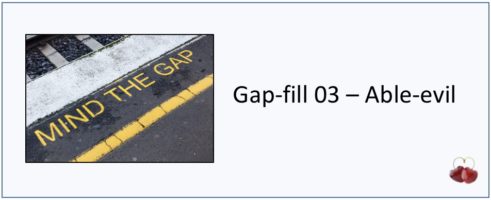45 – Gap-fill 03 – Able-evil
At the end of Listening Cherry 43, I included a recording which contained six instances of the the words be able to which is given again below. My focus in this posting is on the penultimate sound shape – which contains just able on its own – where the word sounds (to my ears) close to the word evil.
This sound shape comes from a four-second extract (transcript below) containing ten words, in which able occurs on its own in speech unit 04. The speaker is Karam, from California, recorded in 2003.
01 || NOT || 4.0
[pause 0.316]
02 || Everybody || 5.1
03 || …is… || 4.3
[pause 0.232]
04 || Able || 4.2
05 || TO || 3.2
06 || TEACH someone else a SKILL || 5.1
Now listen to her able on its own – first at original speed, and then at 50% speed.
To my ears, it sounds close to evil with the diphthong |eɪ| being smoothed towards a version of its second element |ɪ| (or, you could argue, a raised version of its first element) and with the consonant |b| being blurred towards |v|.
So what do we do – what can we do – about this kind of dramatic difference between the citation form of able and the sound shape evil in the teaching of the sound substance?
The evil soundshape is not a predictable one. It is extremely unlikely that any work which starts with the citation form and proceeds to derive by rule a range of candidates would include evil. This is – possibly (but I doubt it) – a unique occurrence, a one-off. But it has occurred. So it could occur again. That might make it worth learning.
But what it is representative of is the fact that – in the Jungle – ‘anything can happen for no apparent reason’. So in teaching listening/decoding we need to think of words as extremely malleable flexiforms, streamlike phenomena which can be coaxed or bullied into a large range of soundshapes.
A few principles therefore:
- Accept what happens (because anything can happen)
- Don’t turn one event into a rule
- Give learners practice in handling a variety of soundshapes
- Encourage them to bend soundshapes in unlikely/extraordinary ways
In the table below, I demonstrate a possible range of sound shapes for to be able to . These are scripted speech units, each of which has the same vowel in both prominent syllables – so in 01 for example the long vowel |iː| occurs in both STEVE (column 2) and LEAD (column 4). In column 3, the word able is flavoured with the same long vowel. The audio contains three instances of each speech unit: a fast-speed original, then a slowed down version (50%), then the fast-speed original once more. Some of them may sound very unlikely, even preposterous. But what could be more preposterous than the version that Karam actually gives us above?
In teaching the sound substance of language – helping students learn to decode – we need to practise the preposterous.
| 5 | 4 | 3 | 2 | 1 | |||
| 01 | so | STEVE | was able to/eebulltuh | LEAD | them | ||
| 02 | and | BELL | -a was able to/ebbluh | TELL | them | ||
| 03 | in | TIME | i was able to/eyebulluh | FIND | |||
| 04 | so | JOY | was able to/oibulluh em | PLOY | them | ||
| 05 | and | JUL | -ia was able to/oobulluh | FOOL | them | ||
| 06 | so | BERT | was able/erbulluh | SERVE | them | ||


